|
Monday
11 July 2005
Itĺs
a gray morning and it is raining cats and dogs. We have breakfast in the tiny
breakfast room of the guesthouse. We go to Kaskoĺs supermarket to buy some
food for the day. We are early so we have to wait a while, before can buy some
drinks and ready made sandwiches. We drive to the North out of town along the
north coast. It is very foggy and visibility is less than 50 metres at times.
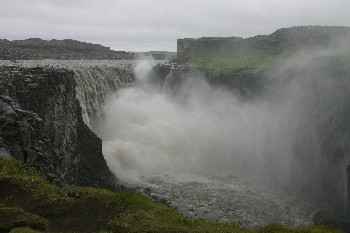 Iceland
looks a lot less attractive like this. The road is fine and sealed (contrary to
what the map indicates) and within an hour we arrive in Asbergy , the gateway to
J÷kulsßrglj˙fur
National Park. The park ranger at the information centre explains us
extensively what our walking options are. We decide to take the 864 to the
waterfalls. And to walk from one set of falls to another and back. It keeps on
raining, which does not exactly lift our spirits for a long walk. We take route
864 on the east side of the canyon, which, according to the ranger, is much
better than route 862 on the west side. How bad that road would be we do not
know, but 864 starts easily enough, but gradually turns into a track full of
potholes mud pools. We are not to be deterred but at times we can only hope not
to get stuck in the mud. After 45 minutes we arrive at Hafragilsfoss. We get out
of the car put on our waterproof gear and head for the Dettifoss. The walk takes
along the edge of the canyon through lava fields with little vegetation. Only
some moss and a few tiny flower manage to grow here. After an hour and countless
vistas we reach Dettifoss. It is fairly busy here (most tourist approach this
site from the south). Dettifoss is very impressive. With lots of noise the water
falls 45 meters down Iceland
looks a lot less attractive like this. The road is fine and sealed (contrary to
what the map indicates) and within an hour we arrive in Asbergy , the gateway to
J÷kulsßrglj˙fur
National Park. The park ranger at the information centre explains us
extensively what our walking options are. We decide to take the 864 to the
waterfalls. And to walk from one set of falls to another and back. It keeps on
raining, which does not exactly lift our spirits for a long walk. We take route
864 on the east side of the canyon, which, according to the ranger, is much
better than route 862 on the west side. How bad that road would be we do not
know, but 864 starts easily enough, but gradually turns into a track full of
potholes mud pools. We are not to be deterred but at times we can only hope not
to get stuck in the mud. After 45 minutes we arrive at Hafragilsfoss. We get out
of the car put on our waterproof gear and head for the Dettifoss. The walk takes
along the edge of the canyon through lava fields with little vegetation. Only
some moss and a few tiny flower manage to grow here. After an hour and countless
vistas we reach Dettifoss. It is fairly busy here (most tourist approach this
site from the south). Dettifoss is very impressive. With lots of noise the water
falls 45 meters down
We
walk back in an hour and drive back towards H˙savÝk. At Asbergy we pick up two
hitch hikers from Berlin who traveling through Iceland for 6 weeks. They make
long trekkings through the interior and cover some larger distances by bus.
Today is a bad day: it is raining and they have waiting for a lift for 45
minutes. We drop them at the supermarket in H˙savÝk.
In
the afternoon we visit the whale museum. It was set up by an Icelander who has
devoted his life to the protection of the whales around Iceland. It is nice
enough, but a lot of the same. They do have skeletons of five different whale
species. There are also a number of TV documentaries on show about the hunting
and protection of whales.
At
night we eat a Gamli Baukur. Fairly good quality at hefty prices. We make an
evening stroll through boring Husavik and make some photos of the magnificent
scenery of snow capped mountains around the bay.
Weather:
rain and fog; 11░C / 51░F
Tuesday 12 July 2005
H˙savÝk
- Myvatn (ReykjahlÝ) : 53km / 85 mi
After
breakfast we leave for Myvatn, Icelandĺs biggest lake. The journey takes us
along road nr 87, a partly unsealed road through a moonlike landscape. Very
impressive. It is not far to Myvatn, about 53km. In ReykjahlÝ we have booked
a room in the Elda guesthouse.
We have coffee in the ReinihlÝ hotel and rent bicycles there. We buy some
food in the supermarket for the bike tour we are about to make around the lake,
a 35 km tour. The weather is fine. That is: 16░C and sunny. The is a strong
wind. First we have to
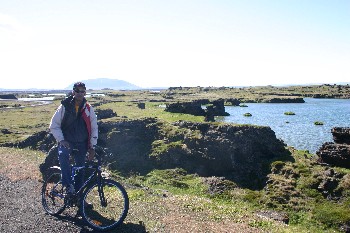 climb
a bit and ride against the wind. It is a lovely route along volcanic craters and
such. We see lots of birds in and around the lake. Half way on our tour we get
tailwind and the cycling becomes that much easier. We stop for picnic at the
banks of a little stream and are promptly visited by the infamous Icelandic
flies. They do not sting but are very annoying. We are back around 3pm. Later in
the afternoon we visit the Myvatn nature baths or: Jarb÷in.
It is a kind of Blue Lagoon: an
artificial bath filled by a thermal well. The sediment contains all kinds of
health stuff. It does have a heavy sulfur smell (like rotting eggs) but you get
used to that after a while. From the baths we have a good view of the mountains
and on the lake. climb
a bit and ride against the wind. It is a lovely route along volcanic craters and
such. We see lots of birds in and around the lake. Half way on our tour we get
tailwind and the cycling becomes that much easier. We stop for picnic at the
banks of a little stream and are promptly visited by the infamous Icelandic
flies. They do not sting but are very annoying. We are back around 3pm. Later in
the afternoon we visit the Myvatn nature baths or: Jarb÷in.
It is a kind of Blue Lagoon: an
artificial bath filled by a thermal well. The sediment contains all kinds of
health stuff. It does have a heavy sulfur smell (like rotting eggs) but you get
used to that after a while. From the baths we have a good view of the mountains
and on the lake.
At
night we eat at the cafÚ next to the ReinihlÝ hotel. Fine food. After that
we take the car for a spin to Vogar to have a look at the Cowshed cafÚ. Which
is indeed a cafÚ in a cow shed. From the cafÚ we can watch the cows in the
stables through a window. But most of the cows, but one, are
now outside in the field. We take a beer.
Weather:
sunny; 16░C / 60░F
Wednesday 13 July 2005
It
is a bright and sunny morning again.
The sky is blue and sunny. Just like in the hotels before this one, the hot
shower has a sulfur smell. This means that even the warm tap comes directly from
the thermal wells. After breakfast we head for a leisurely ride with the car
around the lake. Our first stop is Hverfjell. A volcano that really looks like
one: conic in form and dark in colour. After that
 comes
Dimmuborgir. This is a formation of lava towers. From a view point you
can look over the area. Signposted walks of various lengths (from 15 minutes to
2 hours) lead you through this wonderful phenomenon. We continue to H÷fi.
This is privately owned nature reserve on an isthmus stretching into the lake.
Lots of birds here. We walk around, climb a hill and enjoy the piece and quiet.
A bit further on is Stukkustair. A hamlet with some hotels. Here we find some
pseudocraters. These are not real craters, but solidified lava and formed when
lava stream hit the cold water of the lake. The pseudocraters form a ring in the
lake and are connected to each other by stretches of land. We walk around them
in an hour and see lots of birds among which the hectic arctic stern. comes
Dimmuborgir. This is a formation of lava towers. From a view point you
can look over the area. Signposted walks of various lengths (from 15 minutes to
2 hours) lead you through this wonderful phenomenon. We continue to H÷fi.
This is privately owned nature reserve on an isthmus stretching into the lake.
Lots of birds here. We walk around, climb a hill and enjoy the piece and quiet.
A bit further on is Stukkustair. A hamlet with some hotels. Here we find some
pseudocraters. These are not real craters, but solidified lava and formed when
lava stream hit the cold water of the lake. The pseudocraters form a ring in the
lake and are connected to each other by stretches of land. We walk around them
in an hour and see lots of birds among which the hectic arctic stern.
We
finish our tour and return to ReykjahlÝ . We do some shopping for tomorrow
and have lunch at Zanzibar restaurant. In the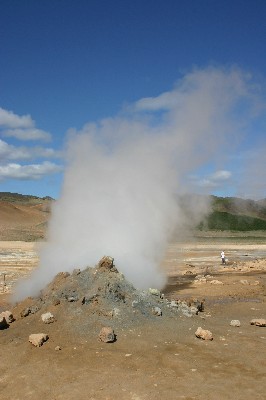 afternoon we drive to Krafla. We first stop at a viewpoint just outside ReykjahlÝ
, with a nice view of Myvatn. Than across the mountains at Grˇtagjß we see a
plain with steaming holes in the ground. The steams smells of sulfur and
phosphor and make a noise. Ropes are put around the patches that are too hot to
stand on. We carry on to Krafla. Here the soil is very active too. So much that
a power plant was built here to gain electrical power from the escaping heat. An
impressive complex. A bit further on is the Viti, a lake that was after a big
outburst in the late 18th century. I walk around the edged. Here too
the soil is very active and some patches are dangerously hot. We return to
ReykjahlÝ where we take a drink at the outside tables of the cafÚ. The
weather is so good that we are sweating in the heat of the sun with just our
t-shirts on. We give the car a wash and drive out to Leinhrj˙kur. This too is
very active with smelling and smoking pools and lavafields formed in the 1980s.
We walk around a bit over a mountain ridge with beautiful views surrounded by
pitch black lavafields and lots of steamy holes.
afternoon we drive to Krafla. We first stop at a viewpoint just outside ReykjahlÝ
, with a nice view of Myvatn. Than across the mountains at Grˇtagjß we see a
plain with steaming holes in the ground. The steams smells of sulfur and
phosphor and make a noise. Ropes are put around the patches that are too hot to
stand on. We carry on to Krafla. Here the soil is very active too. So much that
a power plant was built here to gain electrical power from the escaping heat. An
impressive complex. A bit further on is the Viti, a lake that was after a big
outburst in the late 18th century. I walk around the edged. Here too
the soil is very active and some patches are dangerously hot. We return to
ReykjahlÝ where we take a drink at the outside tables of the cafÚ. The
weather is so good that we are sweating in the heat of the sun with just our
t-shirts on. We give the car a wash and drive out to Leinhrj˙kur. This too is
very active with smelling and smoking pools and lavafields formed in the 1980s.
We walk around a bit over a mountain ridge with beautiful views surrounded by
pitch black lavafields and lots of steamy holes.
At
night we eat pizza at Zanzibar and watch a TV report on todayĺs stage in Tour
de France on a British tv channel. Amstrong is in the lead and has survived an
attack by Botero and Vinokourov.
Later
that night we drive to a lookout and enjoy the midnight sun. The sun is low, but
does not go under. This time of year it never gets dark in Iceland. This takes
some getting used to. The curtains in the hotel rooms are nothing special and
Erik has to improvise every night with towels and clothes and such to make the
room a little bit darker. We end the day with a cold drink at the Cowshed cafÚ.
Weather:
sunny; max. 18░C / 64░ F.
Thursday 14 July 2005
We
rise early and are the first to have breakfast at 7.15 am. We walk to the
supermarket where the super jeep (a modified 4WD car) of Fjallasyn,
Highland Expedition Tours picks us up at 8am for a day tour to Askja.
There is one other passenger, Stefan from
 Germany.
We drive along road nr 1 out east and turn off to the right into F88. Road
numbers starting with 'F' indicate that the road is only suitable for 4WD cars.
We stop for the first time at a dead volcano where can drive into. We walk up to
the volcanoĺs edge for a good view of the area. We continue to follow the F88
along the J÷kulsa a Fj÷llum river. At a cataract we get out of the car and
walk a bit along the river. After a while we arrive at Herubreiarlindir at
the foot of the Herubrei mountain, also called the Queen of the Iceland
mountains. Here we find a simple campsite and a hut. We take a look at a cave
once used by the villain Eyvinur who hid here during the winter of 1774-75 on
a diet of dried horse meat and roots of the Angelica plant. It is fine weather
and we have a clear view of all the mountains Germany.
We drive along road nr 1 out east and turn off to the right into F88. Road
numbers starting with 'F' indicate that the road is only suitable for 4WD cars.
We stop for the first time at a dead volcano where can drive into. We walk up to
the volcanoĺs edge for a good view of the area. We continue to follow the F88
along the J÷kulsa a Fj÷llum river. At a cataract we get out of the car and
walk a bit along the river. After a while we arrive at Herubreiarlindir at
the foot of the Herubrei mountain, also called the Queen of the Iceland
mountains. Here we find a simple campsite and a hut. We take a look at a cave
once used by the villain Eyvinur who hid here during the winter of 1774-75 on
a diet of dried horse meat and roots of the Angelica plant. It is fine weather
and we have a clear view of all the mountains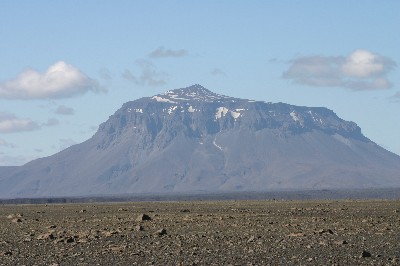 in the area: Dyngjufj÷ll, SnŠŠfell (very special, because usually shrouded in
clouds) and a offshoot of the Vatnaj÷kul glacier. At Drekkagil (dragon canyon)
we make a stop for (our own packed) lunch and a stretch up the canyon towards a
waterfall. We carry on to Askja. This is an
enormous caldera (a collapsed volcano), formed by an eruption in 1875 which sent
clouds of dust all the way to Denmark. From the car park we have to walk some 30
minutes to the Askja lake (Ískjuvatn) at the center of the caldera, which
beautifully mirrors the snow
in the area: Dyngjufj÷ll, SnŠŠfell (very special, because usually shrouded in
clouds) and a offshoot of the Vatnaj÷kul glacier. At Drekkagil (dragon canyon)
we make a stop for (our own packed) lunch and a stretch up the canyon towards a
waterfall. We carry on to Askja. This is an
enormous caldera (a collapsed volcano), formed by an eruption in 1875 which sent
clouds of dust all the way to Denmark. From the car park we have to walk some 30
minutes to the Askja lake (Ískjuvatn) at the center of the caldera, which
beautifully mirrors the snow
 capped
mountains around. Next to it is a smaller lake called Viti (hell), to which I
descend by a very narrow and steep path to have a swim. According to the tourist
brochures it is a place for skinny dipping, but non of the tourists here seem to
bother with that principle. The water is luke warm. The lake was formed when a
magma chamber exploded and the bottom sank. The water in the lake is still
warmed up by the magma underneath. The water has been cooling off the last
couple of years. We walk back to the car. The capped
mountains around. Next to it is a smaller lake called Viti (hell), to which I
descend by a very narrow and steep path to have a swim. According to the tourist
brochures it is a place for skinny dipping, but non of the tourists here seem to
bother with that principle. The water is luke warm. The lake was formed when a
magma chamber exploded and the bottom sank. The water in the lake is still
warmed up by the magma underneath. The water has been cooling off the last
couple of years. We walk back to the car. The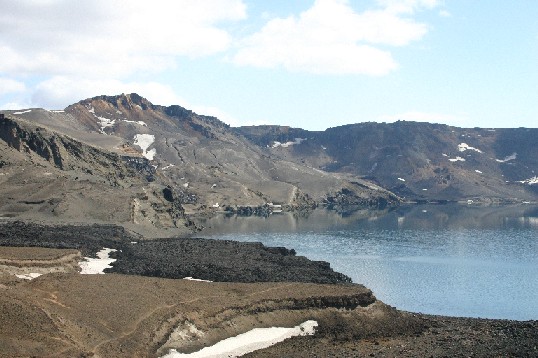 car ride back is along the eastern shore of the river J÷kulsa. We drive through
some kind of moonlike landscape formed by various outbursts. Nothing ever grows
here and the land is covered in pumice. This
is where the astronauts trained with their moon vehicle before they were
launched up there. Later they said that Iceland looked more like the moon, than
the moon itself. From the pumice we drive into the sand and it looks ľ
certainly with this hot weather ľ like entering the desert. We meet an (East)
German family from Brandenburg (Barnim)
who are stranded with their old VW-bus in the middle of all this. We tow them to
the next hamlet of M÷druralur.
There they phone for assistance We have a look at the small church which was
built by a farmer in memory of his deceased wife. The church is no bigger than a
average living room. We drive on towards road no. 1 and on to ReykjahlÝ ,
where we arrive around 8pm.
car ride back is along the eastern shore of the river J÷kulsa. We drive through
some kind of moonlike landscape formed by various outbursts. Nothing ever grows
here and the land is covered in pumice. This
is where the astronauts trained with their moon vehicle before they were
launched up there. Later they said that Iceland looked more like the moon, than
the moon itself. From the pumice we drive into the sand and it looks ľ
certainly with this hot weather ľ like entering the desert. We meet an (East)
German family from Brandenburg (Barnim)
who are stranded with their old VW-bus in the middle of all this. We tow them to
the next hamlet of M÷druralur.
There they phone for assistance We have a look at the small church which was
built by a farmer in memory of his deceased wife. The church is no bigger than a
average living room. We drive on towards road no. 1 and on to ReykjahlÝ ,
where we arrive around 8pm.
Weather:
warm and sunny; max. 22░C / 71░F.
|





